The Black-chinned Hummingbird (Archilochus alexandri) is a small bird with a tiny pale spot behind its eye, and a long, slightly curved beak.
The Black-chinned Hummingbird is similar in size to its eastern relatives, but has a dark purple rather than red gorget, which can appear blackish depending on lighting conditions.
On this page
Identification
The Black-chinned Hummingbird is a small bird with a long, needle-like, slightly curved beak, green upperparts, and dingy gray underparts. Males have a dark throat that gives them a hooded appearance.
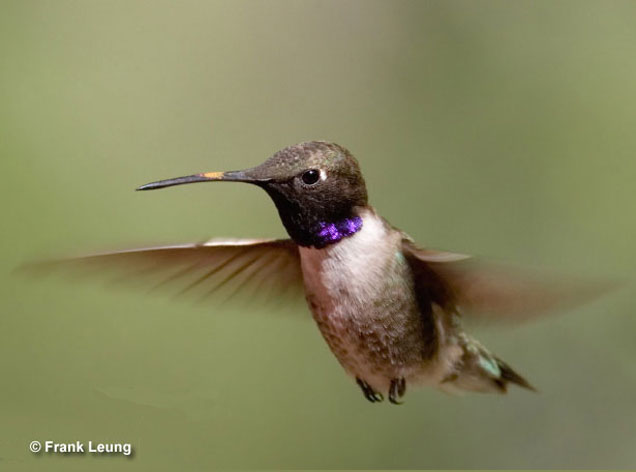
In good light, we can see that male Black-chinned Hummingbirds do have a black chin, but they also have a beautiful, iridescent purple throat (or gorget). This species also has a small pale spot behind each eye, and a “semi-collared look” made by white on its upper chest and the side of its neck.
Like other hummingbirds, it zips around and hovers on whirring wings, and has a black, forked tail. On average, they are 3.75 inches long, have a 4.75 inch wingspan, and weigh .12 ounces.
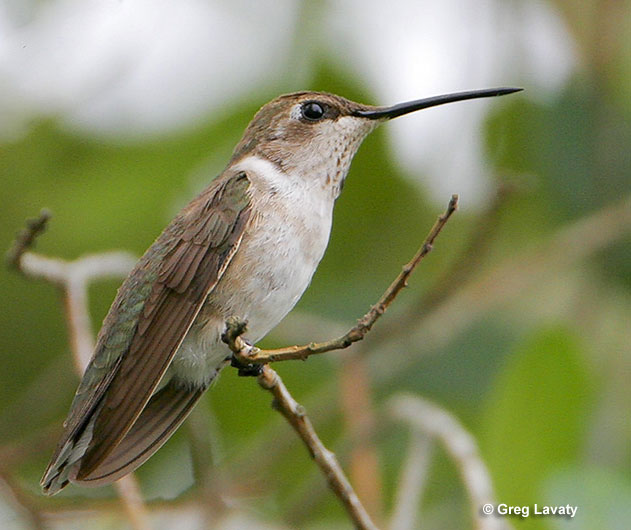
Female Black-chinned Hummingbird
The female Black-chinned Hummingbird also has a pale spot behind her eyes, but she doesn’t have a dark head. Instead, she has small marks on a pale throat and a grayish-green crown. Her underparts are also more uniform grayish than the male, and she has a black and white tip on her slightly forked tail.
Both sexes make a variety of high-pitched chattering sounds. When displaying to females, diving males make a trilling noise and occasionally sing a quiet, warbling song.
Food
The Black-chinned Hummingbird feeds on tiny bugs, spiders, and flower nectar. Although they prefer nectar and sugar water, these hummingbirds may eat more insects and other arthropods at certain times of the year.
To help with the energy demands of egg laying and incubation, females might eat more bugs to gain weight.
They probably also catch more bugs and spiders when feeding their young, and before they migrate. These hummingbirds can also feed on arthropods when nectar isn’t available.
They catch bugs and spiders by picking them from spider webs, catching them in hovering flight, and picking them from vegetation. Nectar, though, is the preferred food source for Black-chinned Hummingbirds.
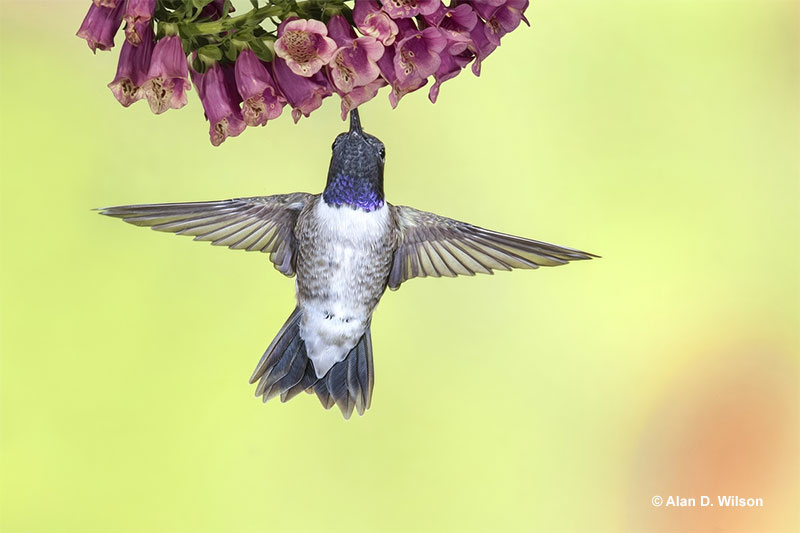
We commonly see these birds perching and hovering as they take sugar water from backyard feeders. However, they also feed on many flowering bushes and trees, and can forage from ground level to high overhead. They have been seen feeding on more than 90 species of plants, including century plants, paintbrush, desert honeysuckle, and thistle.
At backyard feeders, Black-chinned Hummingbirds avoid feeders that use artificial sweeteners and much prefer sugar water over water sweetened with fructose or glucose. When feeding from flowers, the tubular shape of the flower is more important than its color.
Nesting and Eggs
Depending on where it lives, the Black-chinned Hummingbird can nest from April to June. However, most lay eggs in late May and early June. After they pick a mate, female Black-chinned Hummingbirds build a tiny, cup-shaped nest in a tree, vine, or other plant, usually six feet above the ground.
Her mate doesn’t help with any of the nest building nor with feeding the nestlings.
She often nests in a Sycamore but can also choose an oak or other type of tree, and frequently picks a thin branch above or near a stream.
Once the female has settled on a good nesting site, she constructs her nest with small strips of bark, spider webs, cocoon silk, and soft plant fibers.
To mold her nest into shape, the female hummingbird presses her body onto it to give the nest its distinctive cup-like shape. When the nest is ready, she lays two small white eggs that are .5 inches long and weigh .015 ounces.
The female Black-chinned Hummingbird incubates them for 12 days and the young hummingbirds stay in the nest for 21 days after hatching. During this time, their mother feeds them regurgitated food and continues to feed them for a week after they leave the nest.
Current Situation
Black-chinned Hummingbirds live in arid habitats in parts of southern British Columbia and in many places in the western USA west of the Rocky Mountains.
They also occur in central and western Texas and winter in tropical forests habitats of western Mexico. This species is especially common in riparian zones but also lives in backyard gardens and other shrubby habitats.
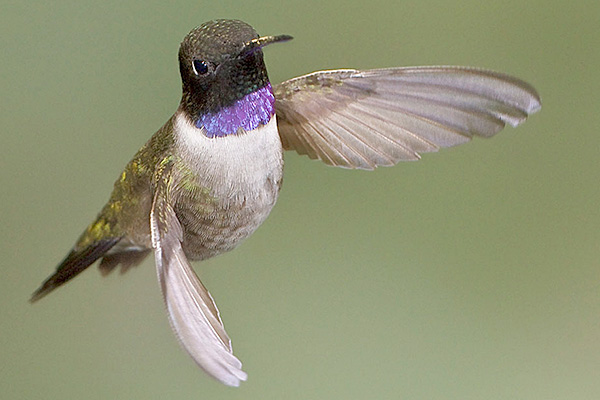
Photograph © Glenn Bartley.
They are listed as Least Concern in the IUCN Red List and are a common and increasing bird in many places.
This species is not considered threatened. On the contrary, the presence of hummingbird feeders and plantings has probably helped it increase in numbers.
However, since they are dependent on wooded riparian zones in arid areas, habitat destruction would probably affect them.
Another concern is whether changes to their wintering habitat could affect their populations.
At the time being, though, Black-chinned Hummingbirds are common birds that are doing well.
Facts
- This species plays vital roles for the pollination of several plants in its range. In many places, it is the only hummingbird present and could be the primary pollinator of the Beard-lip Beardtongue (Penstemon barbatus) and Squawfeather (Castilleja integra) plants.
- As baby hummingbirds grow, the soft nest of the Black-chinned Hummingbird expands in size to accommodate them while still keeping them warm.
- This species is not necessarily attracted to red flowers. Although it will feed from them, Black-chinned Hummingbirds are more attracted to flowers that have the same color as they last ones they fed on.
- Black-chinned Hummingbirds are long distance migrants. These tiny birds fly 2,000 miles over deserts and mountains to reach wintering grounds in western Mexico! In early spring, they make the same journey back north again.
- In some desert areas, this hummingbird species can be very common and nest near each other. In a riparian zone in Arizona, researchers found one Black-chinned Hummingbird nest after another; each was 300 feet from the next nest.
Similar Species
The Black-chinned Hummingbird has some distinctive field marks. Even so, it can look very similar to other small hummingbirds.
Ruby-throated Hummingbird
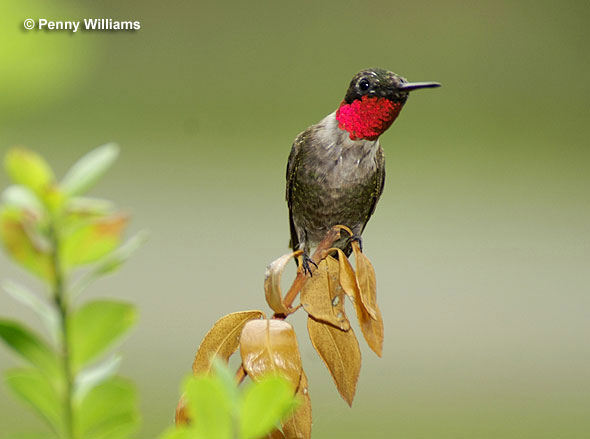
This species is very similar, but fortunately, they don’t usually live in the same area. The male’s purple throat makes it easy to separate it from the Ruby-throated Hummingbird, but females look nearly the same.
However, by carefully reviewing a few key characteristics, we might be able to tell them apart. One way to separate them is by the length of their wings compared to their tail. In the Black-chinned Hummingbird, its wings nearly reach the end of its tail. Perched, Ruby-throated Hummingbirds have tails that go well past their wingtips. Female Black-chinned Hummingbirds are also more uniform gray below and on their crown.
Another feature that can separate females of these two species is the shape of their wingtips. Perched Black-chinned Hummingbirds have rounded and curved wingtips while those of Ruby-throated Hummingbirds are more straight and narrow.
Anna’s Hummingbird
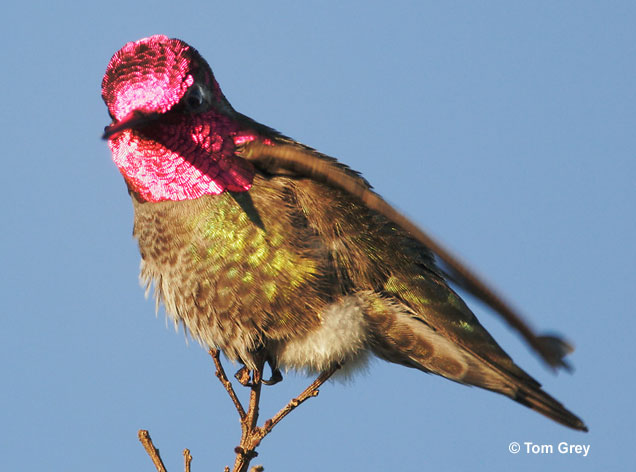
This species can live in some of the same areas as the Black-chinned Hummingbird, although it tends to be more of a coastal bird. The male has a rose-red throat and crown, and lacks the pale semicollar of the Black-chinned.
The female Anna’s Hummingbird has similar grayish underparts but has a straighter beak, often has a few small red spots on her throat, and has a bit of white above her eyes.
Costa’s Hummingbird
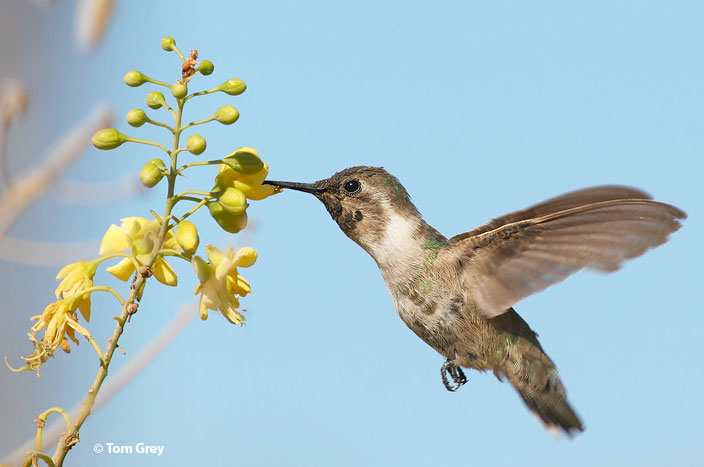
The Costa’s Hummingbird shares habitat with the Black-chinned Hummingbird in southwestern deserts, and the male also has a purple throat. However, the male Costa’s is smaller, and has a gorget with elongated edges and a purple crown.
The female Costa’s Hummingbird is similar to the female Black-chinned but is smaller, has a shorter beak, is whiter below, and has a pale line going back from the eye.
Frequently Asked Questions
Are Black-chinned Hummingbirds rare?
No, Black-chinned Hummingbirds are common birds. They are common birds of gardens of other habitats in southern British Columbia and much of the western USA.
What is the difference between a Black-chinned and Ruby-throated Hummingbird?
The main difference between a Black-chinned and Ruby-throated Hummingbird is their range. Most Black-chinned Hummingbirds live west of the Rocky Mountains while Ruby-throated Hummingbirds live east of the Rocky Mountains. They also have different colors on their throats, and different wing shapes.
Where do Black-chinned Hummingbirds live?
Black-chinned Hummingbirds live in gardens and various arid habitats in southern British Columbia, most of the western USA, and central Texas.
Where do Black-chinned Hummingbirds go in the winter?
Black-chinned Hummingbirds go to western Mexico in the winter.
What flowers do Black-chinned Hummingbirds like?
Black-chinned Hummingbirds like a wide variety of flowers including Sage, Paintbrush, Firecracker Bush, Century Plants, and Beardtongue.


